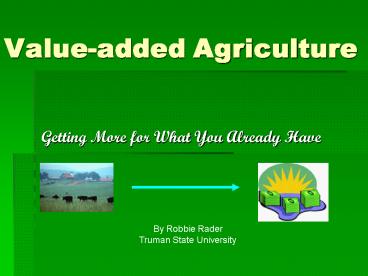Valueadded Agriculture - PowerPoint PPT Presentation
1 / 22
Title:
Valueadded Agriculture
Description:
Strawberries. Tomatoes. Melons. Pumpkins. Sweet Corn. Mushrooms. Growing GMOs. Insect resistant corn and cotton. Round-up Ready soybeans, corn and cotton ... – PowerPoint PPT presentation
Number of Views:264
Avg rating:3.0/5.0
Title: Valueadded Agriculture
1
Value-added Agriculture
- Getting More for What You Already Have
By Robbie Rader Truman State University
2
What is value-added agriculture?
- Increasing the value and appeal of an agriculture
product or commodity through changes in genetics,
processing or diversification - Requires more time, labor and skill than
typically seen in farming operations
3
Why use value-added agriculture?
- Unstable prices for raw commodities
- Federal farm policies
- Changing consumer preferences
- Make more money by cutting out the middleman
4
Concerns with value-added agriculture
- Marketing is critical
- If you cant sell it, you wont make money
- Legal and business restrictions can be
complicating - Do your homework before jumping off the deep end
- Consult the experts
5
Areas of value-added agriculture
- Ag Tourism
- Aquaculture
- Biomass Production
- Energy Production
- Forestry
- Floriculture
- Fruit, vegetable nut production
- Growing GMOs
- Livestock Production
- Organic Food Production
- Specialties
The sky is the limit if you can find a market!
6
Ag Tourism
- Corn mazes and hayrides
- Weddings
- Fishing and hunting opportunities
- Bed and breakfast inns
- Farm tours
- Horse boarding and riding
- Wine tours
- Must have the proper facilities to accommodate
your guests!!!
7
Aquaculture
- Freshwater shrimp
- Stocking and bait fish
- Fish for direct consumption
- Tilapia
8
Biomass Production
- Hay
- Manure
- Biodiesel
- Ethanol
Energy Production
9
Forestry and Floriculture
- Christmas trees
- Nursery stock
- Seed
- Bedding plants
- Turf
10
Fruit, nut and vegetable production
- Blueberries
- Cherries
- Apples
- Peaches
- Pecans
- Black Walnuts
- Grapes
- Raspberries
- Strawberries
- Tomatoes
- Melons
- Pumpkins
- Sweet Corn
- Mushrooms
11
Growing GMOs
- Insect resistant corn and cotton
- Round-up Ready soybeans, corn and cotton
- Disease resistant squash
- Cuts down on chemical costs!
- Be aware of regulations!
12
Livestock Production
- Beef
- Bees
- Elk
- Lambs
- Pork
- Poultry
- Purebred Animals
- Ratites
- Unusual Breeds
- Worms
13
Organic Food Production
- Meats
- Eggs
- Produce
- Honey
- Grains
- Labeling restrictions!
- Must be certified organic!
14
Requirements to be certified organic
- No prohibited substances (insecticides or
fertilizers) for last three years - No synthetic hormones or antibiotics
- Border of 25 feet between organic and
conventional production - No GMO seeds or plants
- Crop rotations
- Third party inspections common!
15
Specialties
- Amaranth
- Herbs
- Prairie Seeds
- Unique Products
- Soaps
- Candles
- Jams
- Wine and cider
16
Getting Started
- Pick something you will have a long-term interest
in - Look at consumer trends
- Consider start-up costs, potential profits and
losses, and any additional costs - Be aware of food safety and labeling issues
- Determine how processing of your commodity would
be accomplished - Federal grants are available
17
Succeeding
- Produce a high quality product
- Start small and grow as demand grows
- Change as markets and demands change
- Build your customer base wisely and keep it
- Allow 3-4 years for returns
- http//www.agmrc.org/homepage.html
18
Small Scale Example
- Rader Farm
- Sell packaged and labeled homegrown honey to a
wide customer base - Marketed as gifts and allergy aid
- Demand is increasing
- Product is in three stores currently
- Profit made each year
- Takes a lot of research
19
Also sell specialty livestock, farm-fresh eggs
and meat
Australian Black Swans
Guineas
20
Summary
- Benefits of value-added agriculture
- Increased profits
- Pride in a high quality product
- Important in changing economy
- Consumer preference
- Web offers vast resources on ideas and
implementation
21
References
- http//www.msue.msu.edu/valueadded/
- http//www.agmrc.org
- http//attra.ncat.org/attra-pub/keystosuccess.html
UpdatingtheKeystoSuccess - http//www.rurdev.usda.gov/rbs/coops/vapgnofa.pdf
- http//www.extension.iastate.edu/Pages/valag/
- http//www.value-added.org/research.asp
- http//www.qualitysystems.ag.iastate.edu/mtg03mar2
4/delate.pdf - http//agebb.missouri.edu/mac/links/index.htm
22
Grant Information
- Missouri
- Nathan Chitwood, USDA Rural
- Development, 601 Business Loop 70
- West, Parkade Center, Suite 235,
- Columbia, MO 65203, (573) 8769320,
- nathan.chitwood_at_mo.usda.gov.































